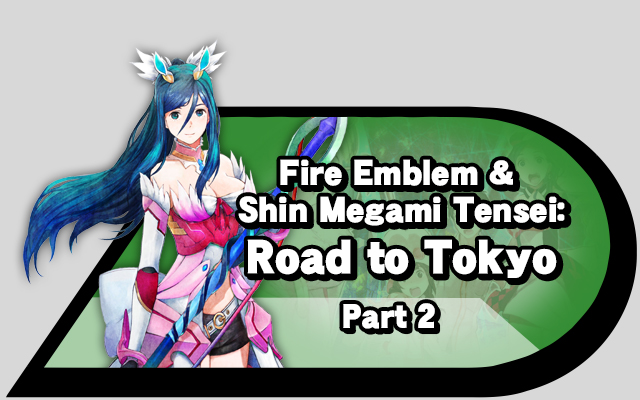
Welcome back to the Road to Tokyo. In Part 1 we took a look at some of the backstory for Tokyo Mirage Sessions ♯FE, where today we’ll be looking at the game as a whole and how it’s shaped up.
On April 1, 2015 during a Nintendo Direct presentation the veil was finally lifted on the true form that Shin-Megami Tensei x Fire Emblem had taken, gone was the mirage of a pure cross over event between characters of both series, and instead the spotlight was put on an unique hybrid, utilizing a brand new setting, brand new characters, and concepts taken from both Shin-Megami Tensei as well as Fire Emblem. The reaction from gamers was one of great confusion, as what they were initially told and finally shown was much different, the game being most closely compared to the modern Persona series titles in large part of it’s vibrant modern setting, upbeat tone and even the Fire Emblem spirits (called Mirages) being more similar to Persona’s themselves.

Once the general development had begun, ATLUS had ideas on what kind of scenarios would take place. Originally it was proposed for the game to use reincarnated versions of past Fire Emblem heroes, but this was deemed too strong of a link to the original source material. To confront this, scenario designers Yo Hadzuki and Makoto Miyauchi instead decided to incorporate them into the ATLUS mythos by using a concept from Japanese Shamanism called “Kami Oroshi” and in specific, a ritualistic dance type “Kagura” where a spirit or deity communicating and/or possessing a dancer, which ties both into the idol entertainment setting for the main characters, as well as the Perfoma concept that ties the heroes with their Mirage spirits. On the use of idols and the Japanese entertainment plot backdrop, ATLUS producer Shinjiro Takada comments from an E3 interview.
This is why the characters are all entertainers: in Japan, similar to Greek mythology, there’s the idea of the gods being connected to the arts, It’s a shamanistic element that’s been interpreted by Atlus. The idea is, Japanese priestesses would dance and the dancing would bring them closer to the gods. We wanted to spin this in an Atlus way, so all the characters in the game have some connection to the arts, and that connection and their ability to express themselves attracts the Mirages to them. People who are good at singing or dancing or acting have really strong bonds with Mirages. (courtesy of Gamespot)
The setting was decided to be built around modern Tokyo (Tokyo and Japan in general being a very common setting for the Shin-Megami Tensei series on a side note) as a close tie to past SMT games. Takada clarifies:
As a result, “a stage set in a modern Japan, an RPG that tells the story of realistic characters growing through various concerns and troubles” became the basis of Illusory Revelations #FE. Interlaced with the essence of Fire Emblem, we decided on the goal of making this a title that goes beyond your average collaboration. (courtesy of Siliconera)
Further sticking close to SMT ideas was the creation of the Mirage alternate dimension, the Idolsphere. This concept is similar to the alternate world for demons as well as the demons themselves seen in the Shin-Megami Tensei games. Fire Emblem producer Hitoshi Yamagami says on the subject of why the Fire Emblem characters were made Mirages and the alternate world was employed
One of the reasons [we made Fire Emblem characters Mirages] is because since it’s an RPG in modern times, we can’t have a Pegasus Knight suddenly show up and have the player think that it all makes sense,” Yamagami explained. “Because Fire Emblem has its own world, we had to have these characters enter the modern world as visitors from a mirror dimension, called the Idolosphere. And as there are ally units like Chrom and Shiida who come from this world, there are also antagonists that come from that world as well and want to destroy our world. (courtesy of Gamespot)
With the world and tone decided, the game’s locations were built, with the real world story segments being based around Tokyo as closely as possible, the bright colors used to emulate and tie to the focus the game has on the entertainment industry. Meanwhile, the idolspheres dungeons were designed to mimic certain real life locations while utilizing fantasy motifs to better fit the Fire Emblem characters, each incorporating a different gimmick (for example one of the first dungeons being shown being based around Fashion that was inspired and designed around the Shibuya 109 department store).

With a heavy emphasis on the entertainment industry and singing, a great amount of detail had to go toward both the soundtrack as well as the in game performances. Composer Yoshiaki Fujisawa notes:
Since “entertainment” is a big theme of Shin Megami Tensei X Fire Emblem, Fujisawa explains that the game is full of songs that bring out the feelings of the stages and floors, and plenty of groovy tracks. (Translation courtesy of Siliconera)
Meanwhile, the stage performances seen in the game were handled by Aburai for the Avex Group (with Studio Anima assisting on the 3D animation used), with care taken for each characters performances to take into account their personalities and professions to better tie the performances together.
With any good RPG however, the story and atmosphere is only one half of the presentation. Join me next time where we’ll take a look at the battle system of Tokyo Mirage Sessions ♯FE and give a final preview of what gamers can expect for when Tokyo Mirage Sessions ♯FE launches June 24, 2016 in North America.

- Smash Ultimate Development Timeline - May 16, 2020
- Straight from the Source: Koji Igarashi on Castlevania in Smash, Bloodstained - October 16, 2018
- Sakurai Discusses Isabelle, Echoes, and Newcomers - September 26, 2018








